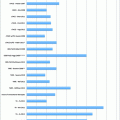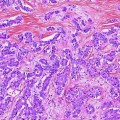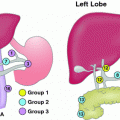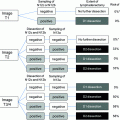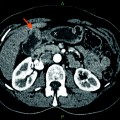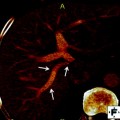Study
No. of patients
R0 (%)
Radiotherapy
Chemotherapy
Locoregional failure (%)
Median survival (months)
P value
Kim et al. [29]
72
65
EBRT 40 Gy (split course, in 6 weeks)
Bolus 5-FU
47
25
–
Todoroki et al. [2]
29
4
IORT 21 Gy, EBRT 43 Gy, or the combination
None
21
32
0.01
20
No radiation
None
69
10
Schoenthaler et al. [28]
6
0
EBRT 54 Gy, 1.8 Gy/fraction
None
–
21.5
0.01
15
60
No radiation
None
16
Sagawa et al. [5]
39
49
EBRT 37 Gy + ILBT 37 Gy or EBRT 38 Gy
None
–
23
NS
30
No radiation
None
20
Gerhards et al. [3]
71
14
EBRT 46 Gy or EBRT 42 Gy + ILBT 10 Gy
None
–
24
<0.01
20
No radiation
None
8
Pitt et al. [49]
14
68
EBRT ± Ir-192 13 Gy
None
–
20
NS
17
No radiation
None
20
Nakeeb et al. [50]
42
75
EBRT (no details)
Bolus and CI 5-FU; gemcitabine
–
16.4
–
Ben-David et al. [12]
28
43
EBRT 54 Gy (median)
54 % of patients; 5-FU, gemcitabine, floxuridine, bromodeoxyuridine
39
24.1 (R0); 15 (R1)
–
Kim et al. [4]
115
78
EBRT 45 Gy (median), 1.8 Gy/fraction
Concurrent 5-FU-based chemo
41.5
36.4
0.007 (LRF); 0.049 (OS)
53
38
No radiation
None
55.6
27.9
–
Nelson et al. [31]
45
80
EBRT 50.4 Gy (median); ILBT (4 patients)
5-FU-based
22
34
–
Hughes et al. [30]
34
24
EBRT 50.4 Gy (median), 1.8 Gy/fraction
5-FU-based
30
36.9
–
Todoroki et al. [2] published a retrospective analysis of 63 patients who underwent resection of Klatskin tumors between 1976 and 1999. Forty-nine patients had R0 or R1 resections, of which 29 were treated adjuvantly with IORT, EBRT, or a combination. The 5-year survival was 33.9 % in the cohort that was treated with adjuvant radiation and 13.5 % in those who were observed (p < 0.01). Patients who had a combination of EBRT and IORT had better survival than those treated with either modality alone. Locoregional failure was diminished in the group that received adjuvant radiation: 20 % compared to 69 %. Initially, high toxicity rates were seen in the IORT group thought to be related to large single electron doses. These toxicities diminished after dose adjustment.
Likewise, a 2003 study by Gerhards et al. [3] suggested a survival benefit with adjuvant radiation. Ninety-one patients underwent mostly margin-positive surgical resection (86 %) for hilar cholangiocarcinoma, of which 71 received EBRT, intraluminal radiation, or a combination. The median survival for those that received radiation was 24 months, compared to 8 months in those observed (p < 0.01).
Most recently, Kim et al. [4] reported on 168 patients with extrahepatic biliary tract cancer who underwent resection between 2001 and 2009, of which approximately 70 % were margin negative. Postoperative chemoradiation with EBRT and concurrent 5-fluorouracil-based chemotherapy was administered to 115 of 168 patients. After a median follow-up of 33.8 months, the median survival was 36.4 months in the adjuvant treatment group, versus 27.9 months in the observation group, which was statistically significant on univariate analysis (p = 0.049) and multivariate analysis (p = 0.005). Likewise, locoregional failure was lower in the adjuvant treatment group on univariate analysis (41.5 vs. 55.6 %, p = 0.007) and multivariate analysis (p = 0.001). Other significant poor prognostic indicators on multivariate analysis included perineural invasion, vascular invasion, poor differentiation on histology, and positive resection margin.
Other series, however, were more equivocal in regard to benefit of adjuvant radiation therapy. Sagawa et al. [5], who reported on patients with hilar cholangiocarcinoma who underwent surgical resection, did not reveal an overall survival benefit in a subset that received adjuvant radiation. Of the 69 patients reported, approximately 50 % had R0 resections. Thirty-nine patients received EBRT with or without brachytherapy, and the others were observed. After a median follow-up of 32 months, 3-year survival was 40.9 % in the adjuvant therapy group compared to 33.3 % with surgery alone (p = 0.554).
Population studies have not demonstrated a clear benefit from adjuvant radiotherapy. In a Surveillance, Epidemiology and End Results (SEER) analysis by Shinohara et al. [6], 4,758 patients with extrahepatic cholangiocarcinomas treated with surgery or radiation between 1998 and 2003 were assessed for overall survival. Of these patients, 28.8 % underwent surgery alone, and 14.7 % underwent surgery and radiation therapy. Although the median survival was 16 months in the surgery and radiation group compared to 9 months with surgery alone (p < 0.0001), this did not hold after adjusting for potential confounders. A similar SEER analysis of patients with resected extrahepatic cholangiocarcinoma, which excluded patients with less than 3 months of follow-up, demonstrated no benefit from adjuvant radiation in local or locally advanced disease [7].
Gallbladder Cancer In the case of gallbladder cancer, there are fewer studies of adjuvant radiotherapy (Table 2). Like studies in extrahepatic cholangiocarcinoma, median survival in the majority of studies was approximately 2 years. Balachandran et al. [8] published a report on 117 patients with gallbladder cancer, of which only 37 underwent extended resections. Of the 117 patients, 73 received adjuvant chemoradiotherapy. Although no details were given regarding adjuvant chemoradiotherapy, the median survival for the adjuvant treatment group was 24 months compared to 11 months in the surgery-alone group (p = 0.001). Those patients who did not have extended surgical resections or had node-positive or T3 disease appeared to benefit more from adjuvant chemoradiotherapy.
Table 2
Adjuvant radiotherapy or chemoradiotherapy for gallbladder cancer
Study | No. of patients | Radiotherapy | Chemotherapy | Median survival (months) | P value |
|---|---|---|---|---|---|
Kresl et al. [32] | 21 | 54 Gy EBRT | 5-FU bolus | 31.2 | – |
Czito et al. [51] | 22 | 45 Gy EBRT ± 5.4 to 50 Gy boost (5 patients) | 5-FU bolus or CI (82 % of patients) | 22.8 | – |
Balachandran et al. [8] | 44 | None | None | 11 | 0.001 |
73 | Yes; no details | Yes; no details | 24 | ||
Ben-David et al. [12] | 14 | 54 Gy EBRT | Mostly 5-FU-based (54 % of patients) | 23 | – |
Duffy et al. [52] | 16 | No details | Mostly 5-FU-based during radiotherapy; 8 received additional systemic therapy | 23.4 | 0.4 |
99 | None | None | 30.3 | ||
Gold et al. [9] | 25 | 50.4 Gy EBRT | 5-FU bolus | 4.8 years | 0.56 |
48 | None | None | 4.2 years |
A more recent study by Gold et al. [9] of 73 patients with stage I and II gallbladder cancer who underwent R0 resection reported a median survival approaching 5 years. In the 25 patients that received adjuvant chemoradiotherapy, which involved 50.4 Gy in 1.8 Gy per fraction with concurrent bolus 5-FU, the median survival was 4.8 years (vs. 4.2 years for surgery alone). Although not significant on univariate analysis (p = 0.56), overall survival was statistically improved with adjuvant chemoradiation on multivariate analysis, adjusting for T and N stages as well as pathologic diagnosis.
In 2008, Wang et al. [10] described a prediction model for gallbladder cancer using SEER data of 4,180 patients with resected disease, of whom 18 % received adjuvant radiation. In addition to factors such as age, histology, and stage of disease, adjuvant radiation was associated with a significant survival benefit on multivariate analysis. The median survival of those who received radiation therapy was 15 months, versus 8 months in those who did not. In the prediction model, the greatest benefit from adjuvant radiation therapy occurs in patients with T2 or node-positive disease.
1.2 Definitive Radiotherapy
In the series of definitive radiotherapy for unresectable disease, which included patients with gallbladder cancer as well as intrahepatic and extrahepatic cholangiocarcinoma (Table 3), the median survival was approximately 1 year. Although there were no direct comparison cohorts in most series, there was an improvement compared to historical data where the median survival for untreated patients with unresectable cancers of the gallbladder and biliary tract had been only 6–9 months.
Table 3
Definitive radiotherapy or chemoradiotherapy for unresectable cholangiocarcinoma
Study | No. of patients | Radiotherapy | Chemotherapy | Median survival (months) |
|---|---|---|---|---|
Hayes et al. [53] | 14 | 63.5–108.2 Gy; EBRT + ILBT | None | 12.8 |
Alden and Mohiuddin [11] | 24 | 46 Gy EBRT + 25 ILBT | 5-FU ± adriamycin; 5-FU ± mitomycin | 12 |
Morganti et al. [15] | 20 | 39.6–50.4 Gy EBRT ± 30–50 Gy ILBT (12 patients) | 5-FU CI days 1–4 in 19 patients | 21.2 |
Shin et al. [54] | 31 | 50.4 Gy EBRT ± 15 Gy ILBT (14 patients) | None | 7 |
Crane et al. [34] | 52 | 30–85 Gy; EBRT ± ILBT | 5-FU CI in 38 patients | 10 |
Buskirk et al. [55] | 34 | 45–55 Gy EBRT ± ILBT (20–25 Gy; 10 pts) or IORT (15–20 Gy; 7 patients) | 5-FU in 7 patients | 12 |
Urego et al. [37] | 34 | 49.5 Gy (median) EBRT ± ILBT (4 patients) | 5-FU + INFa (27 patients) | 14 |
Ben-David et al. [12] | 52 | 23–86.3 Gy (median 60.2 Gy) EBRT | Mostly 5-FU-based | 13.1 |
Habermehl et al. [13] | 15 | EBRT 45 Gy (median; 25.2–69 Gy); brachytherapy boost in 3 patients | Gemcitabine or FU-based chemotherapy | 12.0 |
Polistina et al. [16] | 10 | SBRT 30 Gy to 80 % isodose in 3 fractions (CyberKnife) | Gemcitabine | 35.5 |
Kopek et al. [18] | 27 | SBRT 45 Gy to isocenter in 3 fractions over 5–8 days | – | 10.6 |
Momm et al. [17] | 13 | SFRT 32-56 Gy, in 4 Gy/fraction given 3 times a week | Gemcitabine or FU-based in 6/13 pts | 33.5 |
Leong et al. [14] | 20 | EBRT 46 Gy (median) in 1.8–2.0 Gy/fraction | Cisplatin/5-FU and gemcitabine | 20.4 |
Alden and Mohiuddin [11] described 48 patients with extrahepatic cholangiocarcinoma in one of the earliest reports of radiation in the unresectable setting. Of these patients, 24 were treated with radiation therapy (EBRT, brachytherapy, or combination) or chemoradiotherapy, 6 underwent resection, 7 were treated with chemotherapy alone, and 11 were untreated. The median survival of the untreated group and chemotherapy-alone group was 4 and 9 months, respectively. The median survival of the group receiving radiation was 12 months, compared to 5.5 months for the 24 patients that did not receive radiation (p = 0.01).
In a retrospective study by Ben-David et al. [12], a subset of 52 patients with extrahepatic cholangiocarcinoma and gallbladder cancer had unresectable or gross residual disease and underwent radiation therapy. The median overall survival in this group was 13.1 months, similar to the study by Alden and Mohiuddin [11]. More recent studies have reported similar median survival times with chemoradiation in the unresectable setting [13, 14].
Long-term survival has also been reported with definitive radiotherapy. In a cohort of 20 patients who received EBRT for extrahepatic cholangiocarcinoma or gallbladder cancer reported by Morganti et al. [15], 2 patients survived beyond 5 years. The majority of patients also received concurrent chemotherapy (5-fluorouracil) and intraluminal brachytherapy.
Studies using hypofractionated or stereotactic body radiotherapy reported promising results, achieving median survival exceeding 30 months in the unresectable setting [16–18] (Table 3). However, these studies report only a limited number of patients and toxicity, at least in some, has been high. This approach requires further investigation. This will be discussed in more detail in the next chapter entitled Emerging Techniques in Image-Guided Radiation Therapy and Stereotactic Body Radiation Therapy.
2 Radiation Technique
The vast majority of the studies supporting the use of radiation therapy in cancers of the gallbladder and biliary tract used 3D-conformal technique. In this chapter, we will discuss this technique in detail including target definition, organs at risk (OARs), and dose selection. We will then introduce the use of intensity-modulated RT (IMRT) and proton beam radiotherapy in the treatment for gallbladder and biliary tract cancers.
2.1 3D-Conformal Radiotherapy
Stay updated, free articles. Join our Telegram channel

Full access? Get Clinical Tree


